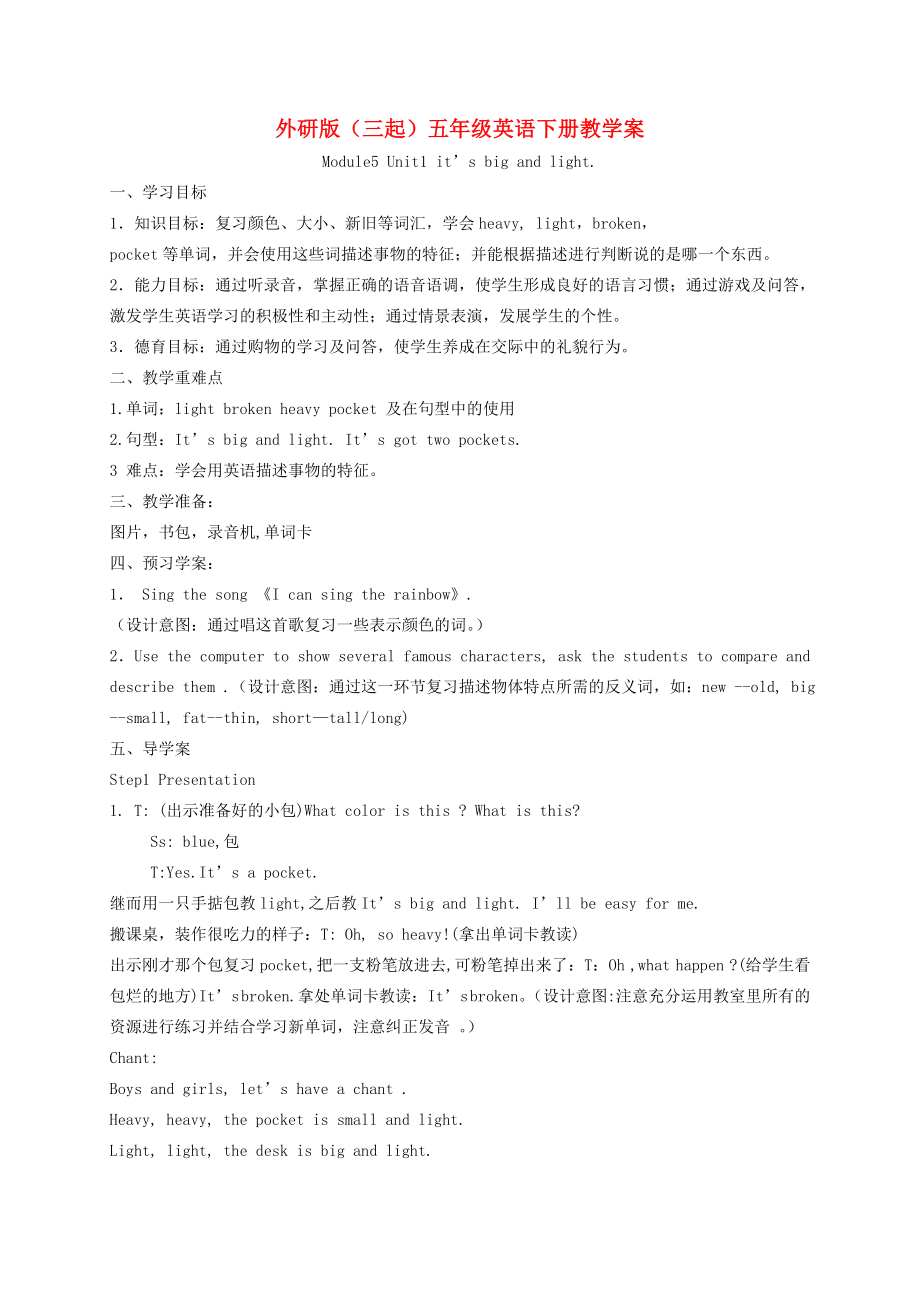《五年級(jí)英語下冊(cè) Module 5 Unit 1(4)教學(xué)案 外研版(三起)》由會(huì)員分享,可在線閱讀�,更多相關(guān)《五年級(jí)英語下冊(cè) Module 5 Unit 1(4)教學(xué)案 外研版(三起)(3頁珍藏版)》請(qǐng)?jiān)谘b配圖網(wǎng)上搜索。
1���、外研版(三起)五年級(jí)英語下冊(cè)教學(xué)案
Module5 Unit1 it’s big and light.
一�����、學(xué)習(xí)目標(biāo)
1.知識(shí)目標(biāo):復(fù)習(xí)顏色��、大小����、新舊等詞匯,學(xué)會(huì)heavy, light�����,broken����,
pocket等單詞,并會(huì)使用這些詞描述事物的特征�����;并能根據(jù)描述進(jìn)行判斷說的是哪一個(gè)東西��。
2.能力目標(biāo):通過聽錄音�,掌握正確的語音語調(diào),使學(xué)生形成良好的語言習(xí)慣��;通過游戲及問答��,激發(fā)學(xué)生英語學(xué)習(xí)的積極性和主動(dòng)性;通過情景表演�����,發(fā)展學(xué)生的個(gè)性��。
3.德育目標(biāo):通過購物的學(xué)習(xí)及問答���,使學(xué)生養(yǎng)成在交際中的禮貌行為�。
二����、教學(xué)重難點(diǎn)
1.單詞:light broken heavy
2�����、 pocket 及在句型中的使用
2.句型:It’s big and light. It’s got two pockets.
3 難點(diǎn):學(xué)會(huì)用英語描述事物的特征���。
三����、教學(xué)準(zhǔn)備:
圖片����,書包�����,錄音機(jī),單詞卡
四���、預(yù)習(xí)學(xué)案:
1. Sing the song 《I can sing the rainbow》.
(設(shè)計(jì)意圖:通過唱這首歌復(fù)習(xí)一些表示顏色的詞。)
2.Use the computer to show several famous characters, ask the students to compare and describe them .(設(shè)計(jì)意圖
3�����、:通過這一環(huán)節(jié)復(fù)習(xí)描述物體特點(diǎn)所需的反義詞����,如:new --old, big --small, fat--thin, short—tall/long)
五、導(dǎo)學(xué)案
Step1 Presentation
1. T: (出示準(zhǔn)備好的小包)What color is this ? What is this?
?? Ss: blue,包
?? T:Yes.It’s a pocket.
繼而用一只手掂包教light,之后教It’s big and light. I’ll be easy for me.
搬課桌�����,裝作很吃力的樣子:T: Oh, so heavy!(拿出單詞卡教讀)
4�����、
出示剛才那個(gè)包復(fù)習(xí)pocket,把一支粉筆放進(jìn)去,可粉筆掉出來了:T:Oh ,what happen ?(給學(xué)生看包爛的地方)It’s broken.拿處單詞卡教讀:It’s broken�。(設(shè)計(jì)意圖:注意充分運(yùn)用教室里所有的資源進(jìn)行練習(xí)并結(jié)合學(xué)習(xí)新單詞,注意糾正發(fā)音 。)
Chant:
Boys and girls, let’s have a chant .
Heavy, heavy, the pocket is small and light.
Light, light, the desk is big and light.
(設(shè)計(jì)意圖: 用實(shí)物形象直觀�����,學(xué)生更容易
5���、理解新單詞,TPR教學(xué)方法能給學(xué)生真實(shí)語境學(xué)習(xí)英語.輕快的歌謠能鞏固新單詞句子����。)
2. 呈現(xiàn)課文
教師分段播放錄音����,學(xué)生跟讀。 (設(shè)計(jì)意圖: 讓學(xué)生聽錄音初步了解課文內(nèi)容��。)
教師向?qū)W生講解“We’ll take it ,please.”中take的意思為buy����。
Step2 ?Practice
(設(shè)計(jì)意圖:整個(gè)操練中有交際操練�����,有錄音�����,也有游戲���,教學(xué)方法多樣豐富�,既能活躍課堂氣氛,又能使學(xué)生自主學(xué)習(xí)��,讓學(xué)生樂于學(xué)習(xí)��,互相交流合作����。)
1. Listen to the tape and look at the book. Ask and answer the question
6、s.
1) Why does Ms Smart want to buy Lingling a new bag?
2) How many bags do they see?
3) Why don’t they choose (選擇) the black one?
4) Which one do they choose? Why?
2. Listen again and then answer the questions.
1) Why does Ms Smart want to buy Lingling a new bag?
Because Lingling’s bag
7�、 is broken.
2) How many bags do they see? Three.
3) Why don’t they choose (選擇) the black one? It’s (too) heavy.
4) Which one do they choose? Why?
They choose the blue one. Because it’ big and light, and it’s got four wheels.
3. Follow the tape to read the text.
4.交際性活動(dòng)設(shè)計(jì)Practice the dial
8、ogue in the group .
(設(shè)計(jì)意圖:通過分組分角色朗讀�����,開展合作學(xué)習(xí)���,相互促進(jìn)����,并在模擬情境表演中鞏固新語言。)
5.趣味性活動(dòng)設(shè)計(jì):接龍游戲
Now , let’s have a game . For example:
T: The bag is light.
S1: The bag is light and new.
S2: The bag is light and new and nice.
S3: The bag is light and new and nice and big.
Do the practice in groups.
9�����、6����、游戲[我會(huì)說]:請(qǐng)學(xué)生以小組為單位,完成課本中活動(dòng)三��。
e.g: A :It’s heavy. B :It’s the green bag. 要求生B一邊指一邊說���。
7.Let’s chant and act
My eyes big, big ,big
My mouth small, small, small
My clothes nice, nice, nice
This bag heavy ,heavy, heavy
That bag light ,light, light
(設(shè)計(jì)意圖:有節(jié)奏的歌謠瑯瑯上口�,能幫助學(xué)生很快記住這些單詞�。)
Step3.Ho
10、mework
1.Write a compression about animals, use the new words and sentences. 2.給學(xué)生發(fā)以下紙條在小組填
The window is _____ and _____ . The door is ____. The blackboard is____ and ____. The desk is ____ and ____ . The chair is ____ and ____. The children are ____ and ____ . 填好收齊并給學(xué)生評(píng)價(jià)����。
六、板書設(shè)計(jì)
Module 5 Uni
11����、t 1?It’s big and light.
This black bag is nice.
It’s big.
This blue one is big and light.
It’ll be easy for her.
七�����、課后作業(yè)
?(??? )1.Look(??? )your bag.It's broken.
??? A.to?????? B.at?????? C.about
? (??? ) 2.You can't it (??? ) China.
??? A.for??? B.on???? C.to
? (??? ) 3.I;ll buy you a new (??? ).
??? A.a????? B.an??????? C.one
? (??? ) 4.It'll be easy (??? )you.
??? A.for??? B.to???? C.about
? (??? ) 5.-Thank you very much.
??? A. Yes, thank you. B. You're welcome. C. Yes, you are??
 五年級(jí)英語下冊(cè) Module 5 Unit 1(4)教學(xué)案 外研版(三起)
五年級(jí)英語下冊(cè) Module 5 Unit 1(4)教學(xué)案 外研版(三起)

